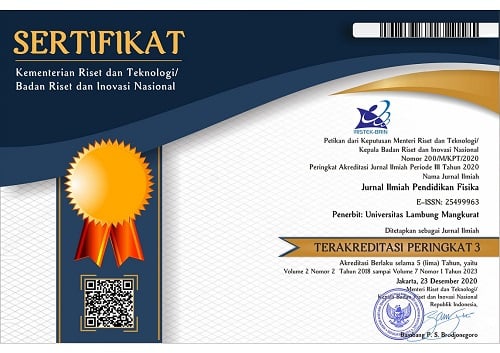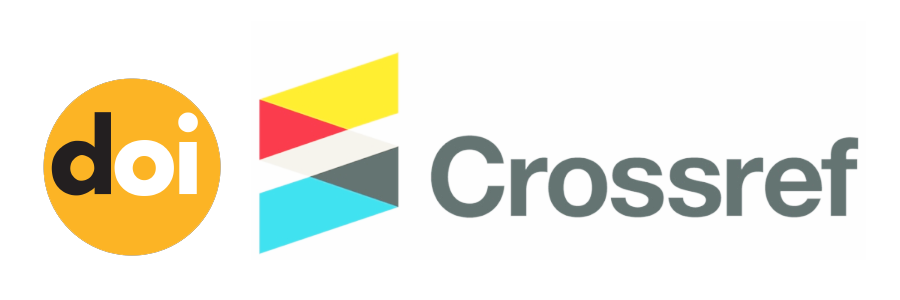Developing Physics Teaching Materials with the SETS Approach on the Kinetic Theory of Gases Topic to Improve Students' Scientific Literacy Skills
Abstract
Scientific literacy as a skill and competence must be possessed in physics learning. However, the ability to be literate has not been well-trained and has received insufficient attention in schools. This research aims to develop teaching materials that are valid, practical, and effective with the SETS approach to enhance the scientific literacy of students. This research uses the ADDIE model as a guideline in developing teaching materials. The research method used is a pre-experimental research trial with 36 students in the 11th grade of Science 2 class at SMAN 11 Banjarmasin. The results of the study show: (1) Physics teaching materials with the SETS approach are considered valid because the worksheets, lesson plans, and teaching materials, as well as the learning outcomes test, are categorized as very good; (2) Physics teaching materials with the SETS approach are considered practical because the implementation of teaching and learning activities is categorized as very good; (3) Physics teaching materials with the SETS approach are declared effective because the N-gain score for scientific literacy is 0.75 in the high category. Thus, physics teaching materials with the SETS approach to the kinetic theory of gases are considered suitable for use in teaching and learning activities to enhance students' scientific literacy because they meet the criteria of validity, practicality, and effectiveness. The results of this research are used as input for teachers and prospective teachers to choose physics teaching materials with the SETS approach on the topic of the kinetic theory of gases to enhance students' scientific literacy.
Keywords
Full Text:
PDFReferences
Afiat, A. R. (2022). Peningkatan literasi sains melalui model problem based learning di sma integral ar-rohmah malang. Dinamika Sosial: Jurnal Pendidikan Ilmu Pengetahuan Sosial , 1(4), 426–437. https://doi.org/10.18860/dsjpips.v1i4.2509
Aini, W., Rachmadiarti, F., Prabowo, P., Hariyono, E., & Prahani, B. K. (2022). The study of implementation sets approach to improve students’ critical thinking skills. Proceedings of the Eighth Southeast Asia Design Research (SEA-DR) & the Second Science, Technology, Education, Arts, Culture, and Humanity (STEACH) International Conference (SEADR-STEACH 2021), 219–228. https://doi.org/10.2991/assehr.k.211229.035
Amalia, R., Sitompul, S. S., & H., M. M. S. (2022). Analisis kesulitan peserta didik dalam penyelesaian soal hots tentang dinamika rotasi pada kelas xi. Jurnal Pendidikan dan Pembelajaran Khatulistiwa (JPPK), 11(2), 1–8.
Andriani, N., Saparini, S., & Akhsan, H. (2018). Kemampuan literasi sains fisika siswa smp kelas vii di sumatera selatan menggunakan kerangka pisa (program for international student assesment). Berkala Ilmiah Pendidikan Fisika, 6(3), 278–291.
https://doi.org/10.20527/bipf.v6i3.5288
Ardianto, D., Firman, H., Permanasari, A., & Ramalis, T. R. (2019). What is science, technology, engineering, mathematics (stem) literacy? Advances in Social Science, Education and Humanities Research, 253, 381–384.
Aswita, D., Nurmawati, Salamia, Sarah, S., Saputra, S., Kurniawan, E. S., Yoestara, M., Fazilla, S., Zulfikar, Putri, Z., Iqbal, M., & Ismail, N. M. (2022). Pendidikan literasi: memenuhi kecakapan abad 21 (pertama). K-Media.
Atmojo, S. E., & Kurniawati, W. (2018). Thematic learning model of science, environment, technology and society in improving elementary students’ science literacy. JPI, 7(1), 59–69. https://doi.org/10.23887/jpi-undiksha.v7i1.12099
Cahyadi, R. A. H. (2019). Pengembangan bahan ajar berbasis addie model. Halaqa: Islamic Education Journal, 3(1), 35–42. https://doi.org/10.21070/halaqa.v3i1.2124
Fautin, S., M., A. S., & Dewantara, D. (2020). Pengembangan bahan ajar fisika berbasis multimodel pada topik teori kinetik gas. Jurnal Ilmiah Pendidikan Fisika, 4(3), 111–125. https://doi.org/10.20527/jipf.v4i3.2057
Fuadi, H., Robbia, A. Z., Jamaluddin, J., & Jufri, A. W. (2020). Analisis faktor penyebab rendahnya kemampuan literasi sains peserta didik. Jurnal Ilmiah Profesi Pendidikan, 5(2), 108–116. https://doi.org/10.29303/jipp.v5i2.122
Gathong, S., & Chamrat, S. (2019). The Implementation of science, technology and society environment (stse)-based learning for developing pre-service general science teachers’ understanding of the nature of science by empirical evidence. Jurnal Pendidikan IPA Indonesia, 8(3), 354–360. https://doi.org/10.15294/jpii.v8i3.19442
Handayani, D. L., & Istiyono, E. (2018). Pengembangan modul fisika berbasis sets untuk meningkatkan kemampuan literasi sains peserta didik sma. Jurnal Pendidikan Fisika Tahun, 571–579.
Hardianti, F., Setiadi, D., Syukur, A., & Merta, I. W. (2021). Pengembangan bahan ajar berbasis sets (science, environment, technology, society) untuk meningkatkan literasi sains peserta didik. Jurnal Pijar Mipa, 16(1), 68–74.
https://doi.org/10.29303/jpm.v16i1.1636
Hartini, S., Thaybah, Mastuang, & Mahtari, S. (2018). Developing of physics learning material based on scientific literacy to train scientific process skills. Journal of Physics: Conference Series, 1097(1). https://doi.org/10.1088/1742-6596/1097/1/012032
Hidayati, A. N., Riyanto, Y., & Nurlaela, L. (2018). The development of discovery learning model with sets approach for science learning in junior high school. Advances in Social Science, Education and Humanities Research, 173, 23–26.
Irsan, I. (2021). Implemensi literasi sains dalam pembelajaran ipa di sekolah dasar. Jurnal Basicedu, 5(6), 5631–5639. https://doi.org/10.31004/basicedu.v5i6.1682
Irwan, A. P., Usman, U., & Bunga, D. A. (2019). Analisis kemampuan literasi sains peserta didik ditinjau dari kemampuan menyelesaikan soal fisika di sman 2 bulukumba. Jurnal Sains dan Pendidikan Fisika (JSPF), 15(3), 17–24.
Istiyono, E., Dwandaru, W. B., & Rahayu, F. (2018). Pengembangan tes creative thinking skills fisika sma (physcrethots) berdasarkan teori tes modern. Cakrawala Pendidikan, 2, 190–200. https://doi.org/10.21831/cp.v37i2.19233
Izzati, A. U., Arifuddin, M., Suyidno, & Misbah. (2020). Pengembangan perangkat pengajaran langsung untuk melatihkan keterampilan pemecahan masalah peserta didik sma. Jurnal Inovasi dan Pembelajaran Fisika, 7(2), 190–199.
Kasumawati. (2021). Upaya peningkatan hasil belajar ipa tentang sifat-sifat benda dan perubahannya melalui penggunaan metode demonstrasi pada siswa kelas iii sd negeri 16 buntok kecamatan dusun selatan kabupaten barito selatan. Jurnal Mitra Pendidikan(JMP), 5(7), 507–516.
Maknun, J., Busono, T., & Surasetja, I. (2018). Envisioning science environment technology and society. IOP Conference Series: Materials Science and Engineering, 306(1). https://doi.org/10.1088/1757-899X/306/1/012064
Medová, J., Sedmáková, Z., Uhrecký, B., & Valovičová, L. (2022). Designing activities to develop statistical literacy in primary pupils while conducting physics laboratory work in informal settings. Education Sciences, 12(246), 1–20. https://doi.org/10.3390/educsci12040246
Muzijah, R., Wati, M., & Mahtari, S. (2020). Pengembangan e-modul menggunakan aplikasi exe-learning untuk melatih literasi sains. Jurnal Ilmiah Pendidikan Fisika, 2(4), 89–98.
Nabilah, M., Stepanus, S. S., & Hamdani. (2020). Analisis kemampuan kognitif peserta didik dalam menyelesaikan soal momentum dan impuls. JIPPF: Jurnal Inovasi Penelitian Dan Pembelajaran Fisika, 1(1), 1–7.
Nurcahyani, D., Yuberti, Irwandani, Rahmayanti, H., Ichsan, I. Z., & Rahman, M. M. (2021). Ethnoscience learning on science literacy of physics material to support environment: a meta-analysis research. Journal of Physics: Conference Series, 1796, 8. https://doi.org/10.1088/1742-6596/1796/1/012094
Odden, T. O. B., Lockwood, E., & Caballero, M. D. (2019). Physics computational literacy: an exploratory case study using computational essays. Physical Review Physics Education Research, 15(2), 1–22. https://doi.org/10.1103/PhysRevPhysEducRes.15.020152
OECD. (2018). Education at a Glance 2018: OECD Indicators. OECD Publishing.
Parmin, P., & Savitri, E. N. (2020). The influence of science, environment, technology, and society in creative industries on scientific based business designing skills of pre-service science teachers. Indonesian Journal of Science Education, 8(1), 27–38.
https://doi.org/10.24815/jpsi.v8i1.15362
Pertiwi, U. D., Atanti, R. D., & Ismawati, R. (2018). Pentingnya literasi sains pada pembelajaran ipa smp abad 21. Indonesian Journal of Naturan Science Education, 1(1), 24–29.
Prasojo, P., Prastowo, T., & Ibrahim, M. (2020). SETS based science teaching materials with guided inquiry learning model to improve learning outcomes in optical geometry materials. International Journal of Multicultural and Multireligious Understanding, 7(6), 10–18.
https://doi.org/10.18415/ijmmu.v7i6.1651
Prastika, M. D., Wati, M., & Suyidno, S. (2019). The effectiveness of problem-based learning in improving students scientific literacy skills and scientific attitudes. Berkala Ilmiah Pendidikan Fisika, 7(3), 185–195. https://doi.org/10.20527/bipf.v7i3.7027
Pratiwi, S. N., Cari, C., & Aminah, N. S. (2019). Pembelajaran ipa abad 21 dengan literasi sains siswa. Jurnal Materi dan Pembelajaran Fisika, 9(1), 34–42.
Rainis. (2019). Penerapan model pembelajaran langsung untuk meningkatkan hasil belajar ipa. Jurnal Pajar (Pendidikan dan Pengajaran), 3(6).
Samaduri, A. (2022). Analisis pemahaman konsep siswa yang
diukur menggunakan tes pilihan ganda beralasan pada mata pelajaran biologi. Jurnal Pendidikan Glasser, 6(1), 109–120. https://doi.org/10.32529/glasser.v6i1.1466
Sarjono, S. (2020). Peningkatan aktivitas dan hasil belajar fisika melalui model pembelajaran sets (science environment technology and society). Jurnal Penelitian Pembelajaran Fisika, 11(1), 100–108. https://doi.org/10.26877/jp2f.v11i1.5830
Schleicher, A. (2019). PISA 2018 Insight and Interpretations. OECD.
Setyosari, P. (2016). Metode penelitian pendidikan dan pengembangan (Keempat). KENCANA.
Sugiyono. (2019). Metode penelitian pendidikan (kuantitatif, kualitatif, kombinasi, R&D dan penelitian pendidikan). Alfabeta.
Sulistiyo, A. K. B., Indriyanti, D. R., & Parmin, P. (2021). Environment material in science learning using problem based learning model with the sets approach in terms of students’ activities and learning outcomes. JISE (Journal of Innovative Science Education), 10(1), 43–49.
Ummah, M., Rusilowati, A., & Yulianti, I. (2018). Pengembangan bahan ajar berbasis literasi sains materi gelombang cahaya. UPEJ Unnes Physics Education Journal, 7(3).
Widiastuti, N. L. G. K., & Purnawijaya, I. P. E. (2021). Improving science learning outcomes through the sets (science environment technology and society) approach. Indonesian Journal Of Educational Research and Review, 4(2), 252–260. https://doi.org/10.23887/ijerr.v4i2.38388
DOI: https://doi.org/10.20527/jipf.v7i3.9239
Refbacks
- There are currently no refbacks.
Indexed by: Jurnal Ilmiah Pendidikan Fisika is licensed under a creative commons attribution-share alike 4.0 international license
Statistics Counter |
















